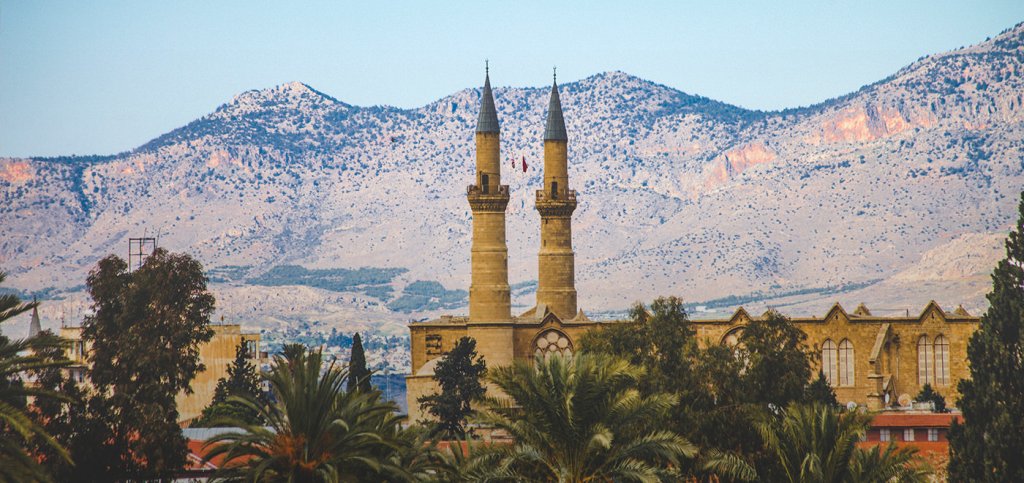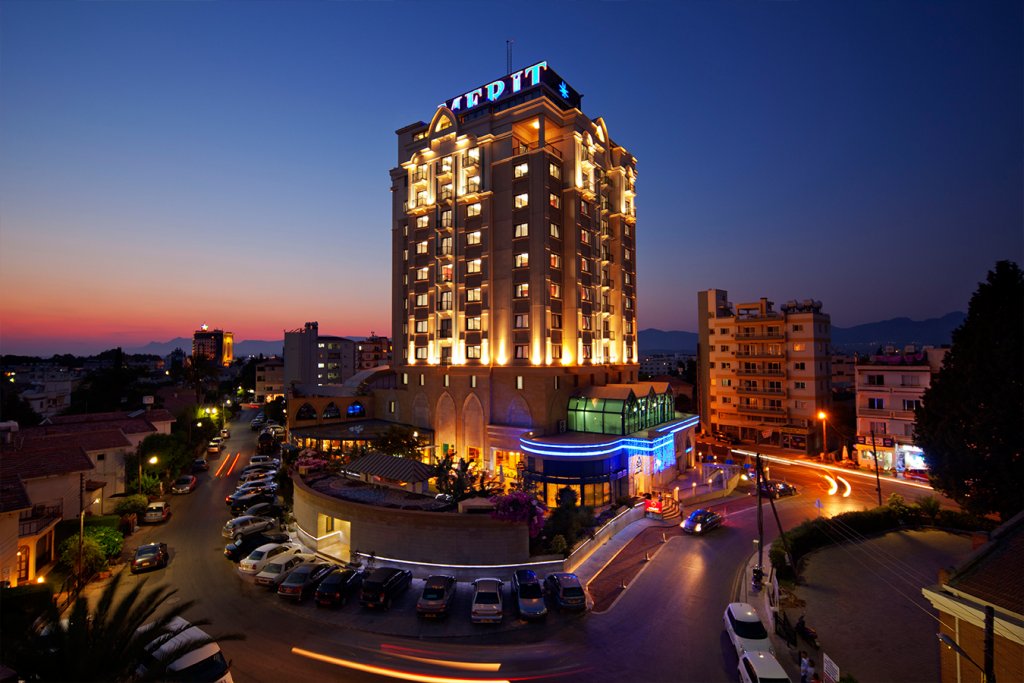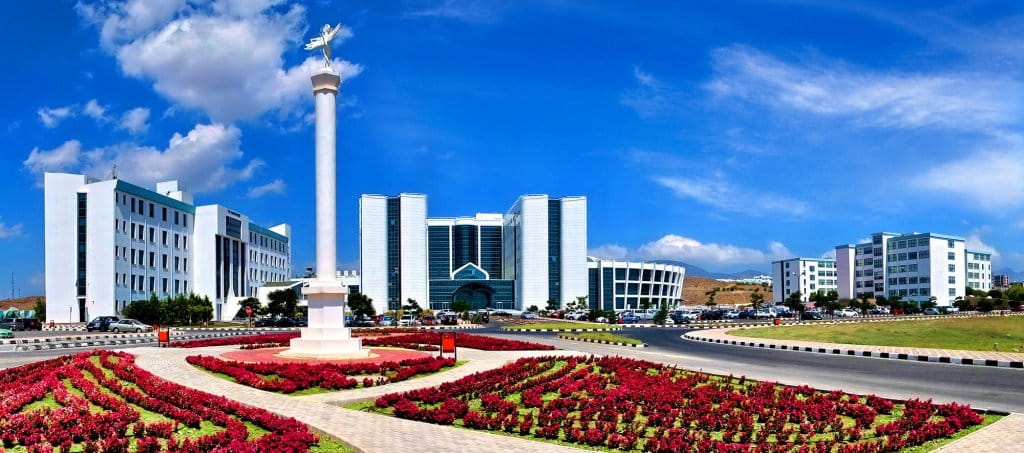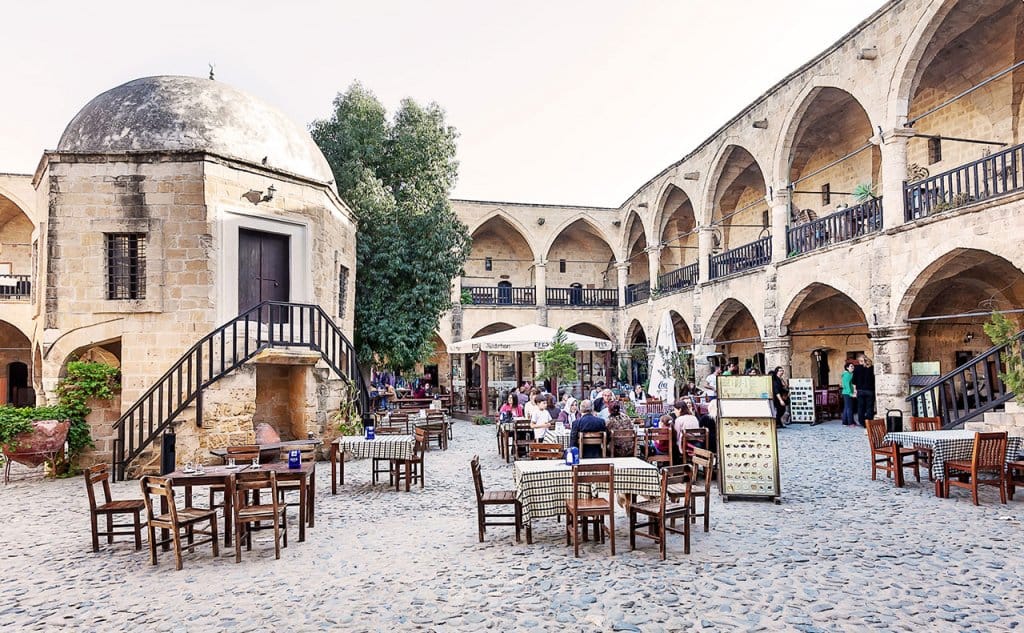Nicosia, the capital of the Turkish Republic of Northern Cyprus. Read the Nicosia region guide with lots of useful information, while reviewing Nicosia housing projects and browsing through Nicosia real estate ads.
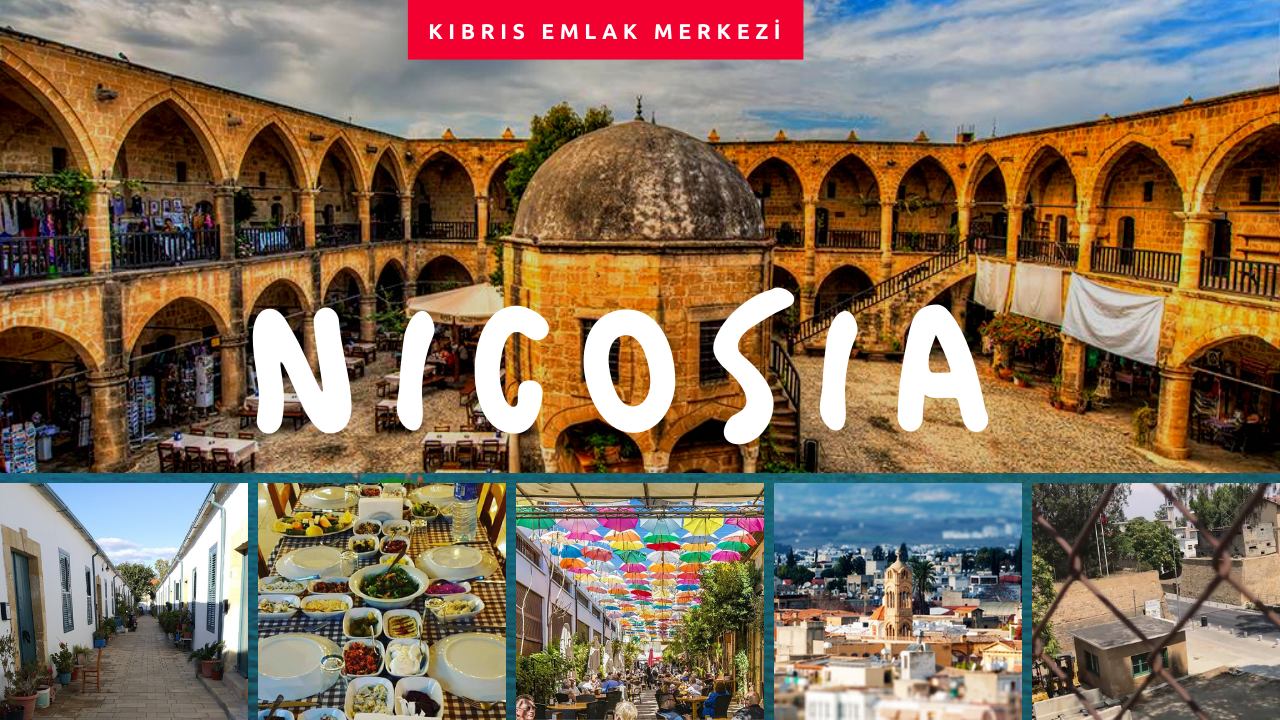
Nicosia, the last divided capital of Europe …
One part is under Turkish rule, the other part under the Greek.
A city with vehicle and pedestrian border crossings to Southern Cyprus.
Nicosia, the capital of the Turkish Republic of Northern Cyprus, is also the center of politics and the business world.
The TRNC Parliament, TRNC Ministries, and the Turkish Embassy are in Nicosia in the North.
The name Nicosia appeared with the arrival of the Lusignians. The French-speaking Lusignians either could not, or did not care to, pronounce the name Lefkosia, and tended to say “Nicosie” translated into Italian and then internationally known as “Nicosia”. The name of the city is recorded at Byzantine sources as “Leukousia”, and is still in use as Lefkosia in Greek and Lefkoşa for Turkish speaking.
Nicosia is a historic walled city, centred on the Sarayönü Square, and a modern metropolitan area, with the Dereboyu region as its centre of business and entertainment. As such it is a city with high levels of welfare and has seen great urban growth and development in the 21st century, including the construction of new highways and high-rises.
The city hosts a large number of tourists and a variety of cultural activities, including international festivals. With a student population over 47,000 Nicosia is an important centre of education and research and is home to six universities, of which the Near East University is the biggest.
The historical centre is clearly present inside the city walls, but the modern city has grown beyond. At the center of the walled city lies the Sarayönü Square, historically the cultural center of the Turkish Cypriot community.
Next to the Ledra Street checkpoint (Lokmadji Check point) is the Arasta area. The area was pedestrianized in 2013 and is home to a network of historic shopping streets, with food and traditional items. Büyük Han, built in 1572 by the Ottomans is the largest caravanserai in the island and considered to be one of the finest buildings in Cyprus, functioning as a cultural center. The Samanbahçe neighborhood, built in the 19th century by the government is considered to be the first example of social housing in the island. Still a residential area, the neighborhood is one of the best representations of the Cypriot culture.
The districts of Nicosia outside the walled city are more spacious, with wider roads and junctions. These areas are characterized by high rise buildings. In the outskirts of the city, a number of large and imposing villas have been built belonging to the middle and upper-classes. The Dereboyu Avenue serves as the modern heart of Nicosia and is its center of shopping and entertainment.
———-
Content Guide:
- Nicosia Map
- Nicosia Population
- Nicosia Turkish Municipality
- Nicosia Weather
- Nicosia Districts
- Nicosia Hotels
- Nicosia Casino
- Nicosia Shopping Mall
- Nicosia Universities
- Nicosia Hospitals
- Nicosia Rent a Car
- Nicosia Nightlife
- Girne Kapısı
- Yiğitler Burcu
- Ledra Palace
- Metehan Border Gate
- Büyük Han
- Kumarcılar Hanı
- Selimiye Mosque (St. Sophia Cathedral)
- Haydarpasha Mosque (St. Catherine’s Church)
- Arabahmet Mosque
- Bedestan (St. Nicholas Church)
- Arasta
- The Great Hammam
- The Mevlevi Lodge Museum
- The Lusignan – Ottoman House
- Cyprus Museum of Modern Arts
- Walled City Museum
- Near East University Classic and Sports Car Museum
- Nicosia Real Estate
- Nicosia Housing Projects
An island in the middle of the sea where the capital in the middle of the island has no coastline… This is Nicosia.
The capital divided into two as North and South Nicosia, has borders with Güzelyurt, Girne and Famagusta in the North.
There are three checkpoints for travellers from North Nicosia to South Nicosia. Metehan (Kermiya)Border Gate, Lokmacı (Ledra Street) Border Gate and Ledra Palace Border Gate.
According to the cencus of 2011, Nicosia has a population of 61,378 and a metropolitan area with a population of 82,539, making it the biggest city in the TRNC.
It has to be noted that only citizens are counted at the TRNC population census. Therefore, the actual population accumulated with military personnel and students as well as foreign workers is significantly higher.
It has been calculated that the number of student alone is more than 47 thousand in Nicosia.
Nicosia Turkish Municipality, founded in 1958, is one of the rare internationally recognised institutions of the Turkish Republic of Northern Cyprus.
The Mayor is Mehmet Harmancı, and the administrative center is in the Yenişehir region of Nicosia.
The municipality features a large variety of social responsibility activities including a classical music orchestra, theater, shelter for women, kindergarten, kitchen for people in need, an annual marathon and other various social support programms for the well being of its citizens.
Nicosia has a climate that is hot and dry in summer and cold in winter.
There is no humidity in Nicosia, because of the lack of the sea and the Five Finger Mountains preventing the humid air flow to come down to the plain. That’s why the Nicosia climate does not overwhelm even with high temperatures during the heat of summer. The insufficient infrastructure brings the traffic to a standstill after heavy rainfalls and bears the risk of flooding especially in the industrial zones.
- Alayköy
- Balıkesir
- Beyköy
- Cihangir
- Çağlayan
- Çukurova
- Değirmenlik
- Demirhan
- Dilekkaya
- Dumlupınar
- Düzova
- Gaziköy
- Gelibolu
- Göçmenköy
- Gökhan
- Gönyeli
- Gürpınar
- Hamitköy
- Haspolat
- Kalavaç
- Kanlıköy
- Kırklar
- Kızılbaş
- Köşklüçiftlik
- Kumsal
- Küçük Kaymaklı
- Lefkoşa Surlariçi
- Marmara
- Meriç
- Metehan
- Minareliköy
- Ortaköy
- Sanayi Bölgesi
- Taşkınköy
- Türkeli
- Yeniceköy
- Yenikent
- Yenişehir
- Yılmazköy
Nicosia is the center of most institutions of the TRNC economy. Those who want to start a business prefer to start in Nicosia. Even though it is preferred for business and working, Kyrenia ranks as the number one to live.
Due to the high number of students in Nicosia rental homes are in high demand. This demand reaches the peak during the registration period of universities. You may have encountered a rise in flight ticket fares and long queues piling up at the immigration at Ercan Airport during these times.
The Gonyeli roundabout is an indication for those wondering if there is ever a traffic congestion in the TRNC. It is a spot where those coming in to Nicosia from Kyrenia get stuck for some time every morning.
If you are thinking of investing in Nicosia, we recommend that you research Nicosia construction companies and Nicosia real estate agencies and filter the ones that suit your requirements for the latest Nicosia housing projects.
Let’s have a pleasant tour in Nicosia first and explore the city in details.
Types of accommodation have been diversified recently in Nicosia.
Previously Nicosia was known as a city with self catering apart-hotels, uncategorized small hotels or Nicosia hostels and a few 5-star casino hotels.
Nowadays, numbers of Boutique Hotels in the historical Nicosia area are rapidly increasing.
Nicosia Boutique Hotels are usually operating in restored historical stone buildings and are predominatly in the Surlariçi region.
Nicosia Boutique Hotels gained high popularity within a short time due to their central location, architecture and quality of service. They are certainly up to competing with luxury hotels in terms of price and occupancy.
Renown holiday booking portals such as Booking.com and Trivago prioritize boutique hotels that add color to Nicosia.
Nicosia hostels were also located in the historical Nicosia area in previous years. Rooms of old houses were rented out to those who could not afford to stay in a hotel of any description. Those places experienced a renaissance after the concept of boutique hotels had been introduced.
Hostels mainly have been transformed into residential flats.
In many parts of Nicosia residence flats for short term rentals have been built. Lefkoşa residences, operated by professional management are preferred due to their affordable pricing rather than hotels.
And then of course there are the Nicosia hotels.
Nicosia has three 5-star luxury hotels.
The first is Merit Lefkoşa Hotel, Grand Pasha Hotel and the recently opened Concorde Hotel.
They are mainly the primary choice of guests visiting the island for business, politics and arts from abroad.
These Hotels, hosting many prestigious events in Nicosia, naturally also feature casinos.
In this sense, they attract many customers from Southern Cyprus.
Apart from those luxury hotels, there is the Saray Hotel, known for its place in the history of Nicosia.
Nicosia Saray Hotel is located at Sarayönü Square close to Kyrenia Gate.
Even though there are many features such as the climate in Cyprus, which is mild even in winter, its history that has hosted many civilizations and their remains surviving to the present; one of the biggest factors in choosing to stay at Cyprus hotels are in fact their casinos.
All 5 star hotels have casinos.
Nicosia casinos serve only those hotels.
There is no independent casino operation like abroad. Outside of hotels there are no casinos, but betting parlors.
Casinos, where local people, military personnel and students are not allowed, offer their customers the promise of great entertainment with events featuring famous artists. That’s why those planning a vacation in Nicosia closely follow the entertainment calendar of the casinos for the selection of their dates.
Famous names of the Turkish music industry as well as the Greek music industry often take the stage at gala nights organized by Nicosia hotels and Nicosia casinos.
Nicosia Casinos List:
Merit Nicosia Hotel & Casino
Concorde Tower Hotel Casino, Convention & Spa
Grand Pasha Nicosia Hotel & Casino
Nicosia Saray Hotel & Casino
City Royal Hotel Casino
Shopping mall culture is not widespread throughout Cyprus, therefore limited in Nicosia.as well.
While those who go to Southern Cyprus and Southern Nicosia praise the shopping malls, there is only one real shopping center in Nicosia in the TRNC.
Located at the Ercan Airport junction, 1001 Airport Mall has a concept of bringing famous brands together under one roof.
Apart from that, Dereboyu Avenue, the busiest location of the city, has independent stores. Many well-known brands such as İpekyol, Mango, Lacoste, Yargıcı, Kiğılı, Sarar, Tommy Hilfiger, Polo Garage, LC Waikiki, Nike, Collezione, Defacto, Tudors have stores in Nicosia.
Local supermarket chains of the TRNC are also to be found in Nicosia.
The most popular of them is Erülkü Supermarket. Located at the Değirmenlik area, the supermarket is in demand from every corner of the island. Especially those returning to their home country from the TRNC take a break at the Erülkü supermarket before going to the airport to pile up their alcohol stocks. The main reasons for this preference are the variety of products, the price advantage that comes with endless campaigns, and the opportunity to pay quickly without waiting at the cash register.
Market chains such as Lemar, Reis and Kiler are also to found at many places in Nicosia.
Although Famagusta is named the university city, Nicosia in fact has a serious potential of students.
Dr. Suat Günsel, a Cypriot businessman started the big transformation of higher education in Nicosia by establishing the evergrowing Near East University.
Near East University, International Cyprus University, Bahçeşehir Cyprus University, Akdeniz Karpaz University, 15th November University and Cyprus American University are among the universities in Nicosia.
Universities operating within the borders of Nicosia also provided a solution by their own means to the problem of public Nicosia bus transportation, often criticized by visitors.
All university offer free transportation for their students.
Nicosia, the capital of the Turkish Republic of Northern Cyprus, is also the capital of health in a sense.
The largest public hospital Dr. Burhan Nalbantoğlu State Hospital is in Nicosia.
The Nicosia Emergency Hospital, inaugurated by President Recep Tayyip Erdogan of the Republic of Turkey was opened during the pandemic as a new investment to the health infrastructure of the TRNC.
In the private sector, the Near East University Hospital, the first full-fledged hospital of the TRNC and the Near East Animal Hospital on the same campus are among those that have been successfully serving the public for years.
Turkey’s powerful medical investors, the Kolan Group, run the British Kolan Hospital in Nicosia.
Etik Hospital, Başkent Hospital and Cyprus Life Hospital are some of the other private Nicosia hospitals.
Nicosia is also known for its IVF treatment centers, which hold a large place in the health sector in Cyprus.
Many of the Cyprus IVF clinics are located in Nicosia.
In fact, Nicosia is a city that you can easily explore as a pedestrian. However, it is not common to walk on roads in the TRNC basically as a side effect of the heat in the long summer months.
Public transport facilities are also not very common.
That’s why those who come for a short-term holiday prefer to rent a car.
Nicosia car rental companies are very professional in this regard.
Most of them have a rent a car office at Ercan Airport.
Those companies also have offices in the center of Nicosia.
Your passport and driving license are sufficient during the Cyprus car rental procedures. No upfront credit card payment is required.
A small suggestion from our side is to check the condition of the vehicle before taking on the delivery. Should there be any previous damages, make sure that they are included in the appraisal report.
In cities nearby the sea, nightlife usually happens at venues with sea view, like businesses in Kyrenia making good use of the sea view. On the other hand, the Capital Nicosia gets over this handicap, mostly with its quality of service. There is music and dance at Nicosia nightlife. However, the emphasis is definitely on Nicosia taverns …
The most delicious and most preferred Cypriot taverns on the island are gathered in Nicosia. Nicosia taverns are very popular with their abundant appetizers, endlessly served meat, varieties of alcohol, their friendliness and pleasant conversation.
In addition to taverns, live music bars are predominantly in Nicosia. There are many places that have good music in the old Nicosia downtown area.
NOTE: Never drive if you are under the influence of alcohol. Do not risk your life and well being as well as those of others. Furthermore, the punishment for drinking and driving in the Turkish Republic of Northern Cyprus is hefty and can lead to getting arrested.
Places worth visiting:
The Venetians errected new walls replacing older Lusignan Walls around the city of Nicosia in order to defend the city in 1571, when the Ottomans were about to take Cyprus. These walls form a circle, with a circumference of three miles, furnished with 11 bastions and three gates. One of the three gates on the walls which surround old Nicosia is the Kyrenia Gate, an important point of entry to the city. This gate was repaired later in 1820-21 by the Ottomans who added a domed watchbox on top.
The Kyrenia gate is still in use today, this time to pass from New Nicosia to Old Nicosia.
Those visiting the historical inns, artefacts and narrow streets pass to the Arasta area by using the Kyrenia Gate.
Access to the famous Saray Hotel, the General Directorate of Foundations and the TRNC Courts is also provided through Kyrenia Gate.
Girne Avenue connects Sarayönü Square to the Kyrenia Gate and the İnönü Square in front of it. In the middle of the Sarayönü Square stands the Venetian Column, known simply as “the Obelisk” (“Dikiltaş”) to the locals. The column was brought from the ancient city of Salamis by the Venetians in 1550.
The avenue has been described as “the symbol of the walled city”, and is filled with numerous shops and restaurants.
It would be advisable to use car parks in this area as parking on the street is almost impossible and can result in unexpected parking fines.
Among the many carparks in the area, Selen Parking is known as one of the most frequented.
Yigitler Burcu (Roccas Bastion)
The bastion is one of the 11 bastions located on top of the Nicosia Walled City.
This is also one of the borders separated by fences between Northern Cyprus and Southern Cyprus located in the Arapahmet district in Old Nicosia.
The Taksim Football Field which has been used by the famous Turkish Cypriot Footbal Club Çetinkaya Sports Club, Ledra Palace, Drakos Square and Paphos Gate at the Greek side have a very good view from the Roccas Bastion. Yiğitler Burcu (the contemporary name of the bastion) is within the borders of the military zone, but is open to visitors during daylight.
The bastion is listed as one of the stops of Nicosia tours for tourists coming to the TRNC as it is a unique place to see the division of the North and the South in person.
On social media, you can see many ‘border’ and ‘wire mesh’ themed photos taken from Yiğitler Burcu.
The Ledra Palace Hotel built during British Colonial times in the 40’s, was designed by the German architect Benjamin Günsberg. Located in central Nicosia, it was one of the most glamorous hotels of the capital. After 1974 following the announcement of ceasefire it fell within the boundaries of the UN Buffer Zone. From thereon the area also was called Ledra Palace, whereas the hotel it self was used as one of the UN headquarters until 2019.
The Ledra Palace Hotel hosted many high level meetings between Greek Cypriot and Turkish Cypriot leaders in the past. Hundreds of structured conflict resolution workshops between Greek Cypriot and Turkish Cypriot peace builders took place there. The buffer zone is still used as a venue for bi-communal cultural events aiming at bringing the two communities closer together as well as for meetings of general interest.
After the opening of borders in 2004 it has become a designated crossing point of the Green Line separating the Republic of Cyprus and the Turkish Republic of Northern Cyprus. As it is a pedestrianized area crossing is only possible by walking. Diplomatic missions hold an exemption and can drive through.
The Metehan Border Gate is located in the Kermia district of Nicosia.
Access is possible on foot, by bicycle or by vehicle.
It is the most frequently used border crossing especially during holidays. Depending which sides holidays it is, long queues and waiting times are to be expected.
In order to take advantage of the EURO/TL exchange rate Greeks from Southern Cyprus often cross over to Northern Cyprus to buy gasoline and groceries, wheras people living in the North use it for special shopping destinations to cross to the South.
The Great Inn is one of the most important Turkish buildings in Nicosia, in terms of historical and architectural value. Sultan Selim constructed shops in order to raise funds for the Ayasofya (Selimiye) Mosque Vakıf (foundation). However, in 1572-1579, Beylerbeyi Sinan Paşa, the Governor of Cyprus, removed the shops and built an inn instead.
The structure is constructed in two storeys, with rooms arranged around a courtyard on a rectangular plan. The small hexagonal prayer room (mescit)with a dome is an important architectural element completing the Turkish atmosphere of the Inn. The rooms on the ground floor were used as barn and stores. The rooms on the upper floor were bedrooms. Throughout Anatolia similar structures of inns are found, but this one has a notable difference by having two entrances.
Located in the Arasta area of the capital city, there are workshops, souvenir shops and restaurants in the Great Inn now, which makes it perfect for a coffee or lunch break. It closes a little early in the evening, so it may be too early for dinner.
The first thing that attracts the attention is obviously the name Kumarcilar Inn to be translated as Gamblers’s Inn. However, the inn was already known as ‘Hımarcılar Inn’, in other words ‘donkeys’ inn before, suggesting it was the inn of saddlers rather than gamblers.
It is an Ottoman inn built in the beginning of the 18th century by Fuat Tüccarbaşı, one of the wealthy businessman of Nicosia. The Gothic tracery of the arch at the entrance, the proportions of these arches countering other arches as well as the absence of Ottoman architectural principals suggest that this may have been built upon an earlier structure. In the two storeys inn, travellers would stay in the upper floor rooms, while rooms on the ground floor were intended as shelter for animals and goods in transit.
Selimiye Mosque (St. Sophia Cathedral)
The construction of this most important Latin Catholic place of worship on the island began in 1194 A.D. and it was consecrated for worship under the name St. Sophia on 5.11.1326 A.D. The cathedral, constructed in early Gothic style, is the earliest French style structure in the Middle East and is recognized as the largest and most magnificent place of worship in Cyprus. Being the most important cathedral on the island, Lusignan princes were crowned kings of Cyprus here. The most striking feature of the structure is the monumental doorway built with limestone blocks from the Kyrenia region. The carved stone windows are unrivalled examples of Gothic art. The building was converted into a mosque after the Ottoman conquest and given the name of Hagia Sophia. The name Selimiye Mosque was given in the 1950’s as a nod to Sultan Selim who conqured Cyprus in 1571.
Haydarpasha Mosque (St. Catherine’s Church)
St. Catherine’s Church was constructed in the 14th century, and converted into a mosque after the island came under Ottoman rule. St. Catherine’s Church, now known as the Haydarpaşa Mosque has the most notable Lusignan structure, after St. Sophia. Particularly noteworthy is the fine stonework in the Gothic Style.
The mosque was built on a derelict church area in the 16th century or the beginning of the 17th century A.D. after the Ottomans conquered Cyprus. It took its present shape when renovated in 1845. It is named after Arap Ahmet Paşa, one of the generals of the Ottoman army in the conquest of Cyprus.
Bedestan (St. Nicholas Church)
The church was built in the 14th century in Gothic style on top of the remains of a Byzantine church, built in the 6th century with the same name. Facing the St. Sophia Catedral in the North it was used by the Orthodox as a Metropolitan Church, the Archbishop Cathedral Church and Virgin Mary Church and the Greek College Church during the Venetian Period. The Ottoman’s used it as a market for textile goods and for storage. After its restoration by an international team, completed in 2010, the building was put in use as a cultural events and arts center.
Arasta is the name for a place where tradesmen and craftsmen come together in order to serve and respond to all kinds of demands. Besides its magnificient historical texture, Arasta offers a wide array of goods from food to drink, sweet to salty, textiles to accessories and even jewelry to its visitors. Most of the Arasta area is pedestrianized, you can walk freely without worries of cars ,enjoying the historical and traditional market.
The Great Hammam was constructed by using the remains of a former Latin church called St. George de Poulains. The floor of the building is 2-3 meters lower than today’s ground level. The Gothic style carved archway at the entrance is from the Lusignan Period. The building was opened to the public to serve as a hammam again after extensive renovation works were completed in 2010.
The Mevlevi Tekke Dervish (Convent) and Museum situated to the south of Kyrenia Gate is one of the most important buildings in Cyprus. Arab Ahmet Paşa lodge for Mevlevi Dervishes was built in the area where the convent is currently located in 1593. Later its name was changed to Ferhat Paşa Convent. The convent in todays form was constructed in the early 17th century. Most Turks who came to the island after the Ottoman conquest were from Konya and were keen to propagate the Mevlevi lifestyle and established this convent in Nicosia. Leading members of the Mevlevi community were buried in rooms to the rear, which became a mausoleum. The lodge now serves as a museum displaying Mevlevi clothing, musical instruments and ethnographic artifacts.
Surviving down to the present day within the city walls of Nicosia, this 15th century mansion is distinguished by its Gothic arched entrance and arms from the Lusignan Period, as well as by the balconies and decorative wooden ceilings added during the Ottoman Period. It is a two storey mansion with a typical internal courtyard, constructed entirely from dressed stone with the exception of the lath and plaster mansion. The restoration was completed in 1997 and the mansion was furnished with authentic furniture from the medieval and Ottoman periods.
The Cyprus Museum of Modern Arts, located on the Near East University campus, is an institution that undertakes the functions of selection, accumulation, protection and exhibition of art in Cyprus, addressing the international platform and its own existence, considering contemporary aesthetic values and understanding. The Cyprus Museum of Modern Arts has been hosting exhibitions by artists from different countries since the day it was opened. The collection consists of works that will best represent their country in the context of art history. In the museum, paintings consisting of acrylic, oil paint, spray paint, airbrush, mixed technique and drawing techniques, wood carving, marble-ceramic sculpture, clay shaping, metal sculpture and handmade hunting knives are exhibited. Especially, the acrylic handmade visual that depicts the historical and cultural details of the Turkic States on the ceiling of the museum entrance attracts attention.
The Walled City Museum, opened at the Kyrenia Gate on November 15, 2020, combines the historical spirit of Nicosia with art. The arts and culture feast at the Walled City Museum features oil and acrylic paintings, original prints, engravings, linoleum, serigraphy, lithography, decals, photographs, sculptures, ceramics and rare artifacts. In the inventory of the Walled City Museum, where artifacts belonging to a different style and period are exhibited on each floor, is a toy car collection consisting of over 3 thousand pieces, samples of swords and knives, more than 70 sculptures, paintings, and objects related to maritime history. There are works of the Turkish Cypriot National History Museum, copies of Karagöz, berat, edict, Kadi registers of Nicosia and Ottoman works such as carpets from the 17th century to be seen as well.
Near East University Classic and Sports Car Museum
The Near East Museum of Classic and Sports Cars, established in 2007, showcases more than 60 vehicles. The oldest vehicle of the museum is the Crest Mobile built in 1899, being a unique model in the world. The NEU Automobile Museum is also the first and only automobile museum of the TRNC.
The population of the city is not stable and when there is a lot of movement because of students, the internet traffic of Nicosia real estate ads does not slow down.
The increase of advertisements for homes for sale in Nicosia generally occurs during the enrollment periods of universities in Nicosia when students and academics are looking for rentals. Those who graduate and leave the island are looking for investments at the same time.
Nicosia ad postings are mostly focused on flats.
Flats are preferred because of their central location in the city and by students predominantly.
Villas are more popular among residents.
Especially for the Yenikent region, the search under the heading of villas for rent and villas for sale in Nicosia never ends.
The demand of living in a villa has been specifically present since the pandemic forced many to live in the narrow space of their flats. Those were the ones keeping the real estate advertisements alive.
Not only residents but also those planning investments considering the future were actively searching property advertisements.
Their demand is concentrated around advertisements for land for sale in Nicosia.
Land for sale in untouched areas with the potential to gain value in the long run are rather in demand than regions where the price is rising and the density of population is increasing.
Outskirts of Alayköy and Değirmenlik districts in Nicosia are areas where advertisements for land sales are concentrated.
Local Cypriot construction companies usually do business in Nicosia.
Their projects have not yet recived demand from foreign investors like in Kyrenia.
The concept of Nicosia housing projects were apartment buildings in town center until recently.
Two-storey buildings with a small garden space at the entrance and a terrace at the the second floor are increasingly built nowadays.
Due to the floor restrictions imposed by the city planning in Nicosia to protect urban zones, building permits in Nicosia are constrained to aviod high rise buildings like in Iskele and Famagusta.
Nicosia housing projects are generally bought / sold for investment purposes rather than for residence purposes.
Sometimes, local investors prefer to rent these residences to students. Sometimes, students from abroad who study at one of the TRNC universities prefer to invest into buying a home instead of spending money on rentals envisaging a profit when selling the property after a stay of 4-5 years.
You will notice this detail when you examine Nicosia real estate ads.
While on the subject, there is an advantage that sets housing projects in Nicosia apart from others. Local construction companies offer the buyer the opportunity to pay cash in hand quite often, providing convenience for domestic investors.
Subscribe to our mailing list to access the latest news







